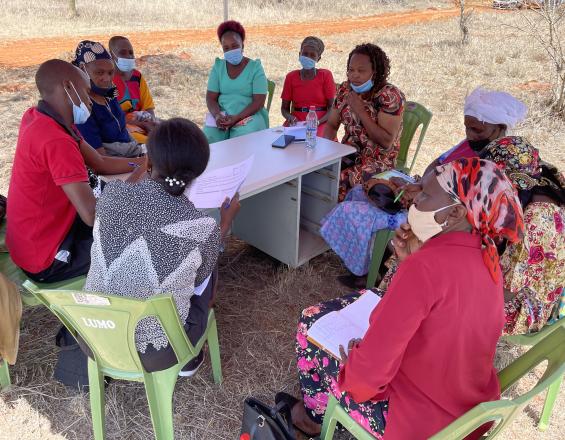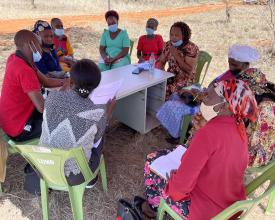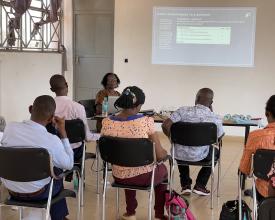Assessment of Governance and Equity of Lumo and Satao Elerai Conservancies for improved conservation and development outcomes.

Wildlife conservancies in Kenya face several governance-related challenges such as biases against women and youth, lack of recognition and respect for the rights of all relevant actors, lack of full and effective participation of all relevant actors in decision making, lack of transparency, information sharing, and accountability by those in authority and lack of equitable benefit sharing. The Kenya Wildlife Conservancies Association (KWCA) has prioritized the assessment of governance and equity among member conservancies with a view to identifying and implementing actions for effective biodiversity conservation and improved livelihoods for the communities. In 2021, KWCA, through the support from BIOPAMA’s Small Technical Grants for Assessment, supported the deployment of the SAGE tool in Lumo Community Wildlife Conservancy and Satao Elerai Conservancy to identify and prioritize actions for strengthening governance and equity for improved biodiversity and social outcomes.
Context
Challenges addressed
Social
- Exclusion of women and youth in conservancy management and decision making processes
Economic Challenges
- Unclear benefit sharing arrangements within conservancies
- Lack of alternative income opportunities
Environmental
- Increased poaching incidences especially for bushmeat due to COVID-19 disruption of livelihoods
- Overgrazing within the conservancies due to unplanned grazing practices
Location
Process
Summary of the process
The building blocks were closely linked and complemented each other to deliver a successful SAGE process. Effective communication was key in co-identification and engagement of stakeholders on the project scope as well on awareness creation, and training of the stakeholders on SAGE tool and processes.
Building Blocks
Stakeholder engagement
The SAGE Assessment is a participatory process involving all the key stakeholders of the conservancy. Identification of stakeholders was carried out at the planning phase of the assessment. This stakeholder mapping was spearheaded by the SAGE consultant and involved Kenya Wildlife Conservancies Association (KWCA), Taita Taveta Wildlife Conservancies Association (KWCA landscape level Association working within Tsavo Landscape) and Amboseli Ecosystem Trust (KWCA Landscape level Association working within Amboseli Landscape). The following stakeholder groups were identified and invited for the assessment workshops: Conservancy management, Conservancy Investors, Youth, Men, Women and Board. The assessments were attended by a total of 99 participants.
Each assessment was followed by a synthesis workshop where each group selected two to three representatives to attend the synthesis workshop. The findings of the assessment workshops were presented at the synthesis workshop and ideas for action were discussed. A total of 46 stakeholders from two conservancies attended the synthesis workshop.
The engagement of all relevant stakeholders in the SAGE ensures that stakeholders are all heard and invested in the actions that they collectively decide on.
Enabling factors
- The collaborative identification of the stakeholders made it possible to exhaustively map all the key stakeholders
- Clustering of stakeholders according to common interest created safe spaces for all (especially women and youth) to openly and productively dialogue on the governance status of the conservancies
- The self-assessment character of SAGE tool fostered community ownership of the process and the identified actions for implementation
Lesson learned
- Effective stakeholders engagement plays a key role in ensuring shared understanding of project scope as well as fostering a collaborative approach to project implementation
- Clustering stakeholders according to interests is a key ingredient to unrestricted and productive discussions especially by those who may be marginalized in terms of governance and decision making processes
- Effective stakeholders engagements enhances ownership of project implementation processes and products
Training on SAGE tool
SAGE is a relatively new tool for assessment of governance and equity in Kenya. The success of the deployment therefore depends on the stakeholders' understanding of the tool, its scope and application. KWCA recruited a trained and certified lead SAGE facilitator who spearheaded awareness creation about the tool to key stakeholders including KWCA, the managers of the two conservancies, and the Landscape Association representatives.
The SAGE tool provides for the recruitment of assistant facilitators to support in SAGE facilitation and note taking. A total of 22 co-facilitators and note takers were recruited, trained and deployed to support the assessment and the synthesis workshop. Their training focused on understanding the SAGE tool, the various principles and the questions as well as basic facilitation skills.
Enabling factors
- Recruitment and contracting of a certified SAGE lead facilitator to spearhead the process
- The easing of COVID-19 movement restrictions enabled the project implementation team to travel and conduct on-site assistant facilitators training
- Participatory identification and recruitment of assistant facilitators ensured successful recruitment of suitable talent to support the process.
Lesson learned
- SAGE Assistant facilitators play a key supportive role in SAGE implementation
- Being a new tool in the country, there is a need for increased training of SAGE lead facilitators to scale SAGE implementation in the country
Effective communication
Communication played a key role in the success of this project. KWCA held a number of virtual meetings from the planning stages to the assessment stage. The choice for virtual meetings was necessitated by the covid-19 pandemic and the associated government measures to control its spread including country lock down thereby disrupting mobility and physical meetings. Some of the virtual calls included planning meetings, inception meeting with the conservancy members to enhance a shared understanding of the project scope and manage stakeholder expectation. Virtual meetings were also held to create awareness of SAGE to the key stakeholders, and to also collaboratively map out the conservancy stakeholders.
The lead consultant, with support from the assistant facilitators, spearheaded the translation of the SAGE principles and questions to the local language for wider uptake especially by the stakeholders who were only proficient in the local language.
Enabling factors
- Translation of the tool to the local language made it possible for wider participation
- Recruitment of assistant facilitators from the local communities and who were proficient in the local languages provided opportunities for productive participation by the stakeholders especially conservancy members.
Lesson learned
- Translation of the tool to the local language made it possible for wider participation
- Effective communication is key in fostering a shared understanding of the project scope, as well as ensuring successful project implementation
- The use of local language is an effective strategy to ensure comprehensive local participation and buy-in, especially when the target audiences are only proficient in local languages.
Impacts
- Despite the project being implemented during the COVID-19 pandemic, we were able to successfully complete all the planned activities within the project time-frame. These activities included stakeholders’ analysis, facilitator training, SAGE assessment, SAGE synthesis workshop and development of actions for implementation
- The project directly reached more participants (145) than was initially intended (60).
- Satao Elerai Conservancy has included youth and women in the conservancy's decision making processes. A youth representative has been included in the conservancy committee and women are now consulted on decision making processes of the conservancy including conservancy meetings.
- Oza, a constituent ranch of Lumo conservancy now includes youth and women in their boards.
- The participatory and self assessment character of the SAGE process made it prossible for all the stakehoders, including women and youth, to participate in the decison making processes of the conservancies.
Beneficiaries
- Conservancy members including women, men and youth
- Conservancy board and management
- Assistant SAGE facilitators drawn from the conservancies
- Private investors in the two conservancies
- Conservation NGOs working with the two conservancies

